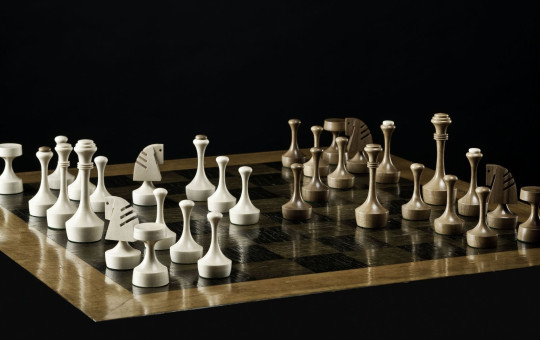Date: 10. October 2019
Time to read: 5 min
Jože Plečnik’s work reflects his belief that the mission of architecture is to achieve immortality. NUK, the National and University Library, is without doubt one of Plečnik’s most important works.
The National and University Library, whose rich collections include numerous medieval manuscripts, incunabula and Renaissance prints, was built between 1936 and 1941 and is the most important of Plečnik’s works in Slovenia. It stands on the site of the former Baroque Princely Palace from the 17th century, which was demolished following the earthquake of 1895.
The exterior of the building bears the influence of Italian palazzos. The design of the distinctive facade with its combination of brick and variously worked stone cladding is modelled on the house of the Roman artist Federico Zuccari. Plečnik did not conceive of the library as a functional building, but as a temple of wisdom for the Slovenian people. The building keeps copies of all Slovenian books, in other words all the knowledge that the Slovenian nation has been able to create.
As the "old" is preserved through knowledge, in Plečnik’s temple of wisdom this symbol can be seen in the very ppearance of the building. On the exterior, among the apparently random mix of brick and stone, the architect installed some stones from the Baroque Princely Palace which previously stood on the site, and even some Roman building stones that were found during excavation of the library’s foundations. In this way Plečnik ensured that the inherited architectural legacy continued to live in the new building.
Path towards the light
The path towards the light is a symbolic path towards wisdom. All of this takes place upon entry into NUK. The entrance to the building is not from the main street, but from a side street. In this way Plečnik sought to emphasise that knowledge is not handed out at the "main gate", that it is not accessible to all, but to the dedicated ones who tread the arduous path uphill towards wisdom. On the main door there is a handle that has been deliberately placed unusually high, as is the high destination that people yearning for wisdom seek to attain. It bears the form of a horse’s head, and this symbol links the profane with the divine; it can traverse between these two states and may also signal a rite of initiation. Pegasus, the winged horse of Antiquity, flew into the heavens to Zeus, and Mohammed flew on a horse into the sky from the rock that stands on the site of what was Solomon’s Temple – today the Al-Aqsa mosque. When those seeking to know more grasp the horse-shaped handle, they are taking a step on the path to knowledge.
Behind the entrance is a large and wide staircase which rises from the dark towards the door of the reading room, above which the window faces south, so the sun may shine through it. The stairs symbolise progress from the dark towards the light. This is a ceremonial path. The staircase is of stone, crowned by imposing columns that symbolise the resolute, unwavering and strong will that is required for advancement.
The entrance to the reading room opens up a new horizon. It is humble, as is learning itself. There is a monumental door on the upper floor, opposite the main entrance to the reading room. It is formed from a combination of various kinds of wood and stone, and the portal itself is of stone that stands out in undulating relief from the stone wall. Through this undulation Plečnik’s door gives the impression that behind it is an especially important space, although in reality it is simply an ordinary room intended for occasional exhibitions.
-
 The selection of the stone was not done at random, as it was also used by the Romans. In this way, Plečnik symbolically pointed to the ancient history of Ljubljana, which dates back to the Roman period. Photo: Tamino Petelinšek/STA
The selection of the stone was not done at random, as it was also used by the Romans. In this way, Plečnik symbolically pointed to the ancient history of Ljubljana, which dates back to the Roman period. Photo: Tamino Petelinšek/STA
-
 Above the side entrance is a bronze statue of Moses, the work of Lojze Dolinar. Alongside the building are indications of the Roman and medieval city walls. Photo: Tamino Petelinšek/STA
Above the side entrance is a bronze statue of Moses, the work of Lojze Dolinar. Alongside the building are indications of the Roman and medieval city walls. Photo: Tamino Petelinšek/STA
-
 The handles to the main entrance doors are in the form of horses’ heads that mimic Pegasus, the mythological winged horse which in this case symbolises a guide for library visitors into the world of knowledge. Photo: Tamino Petelinšek/STA
The handles to the main entrance doors are in the form of horses’ heads that mimic Pegasus, the mythological winged horse which in this case symbolises a guide for library visitors into the world of knowledge. Photo: Tamino Petelinšek/STA
Knowledge must come with morals
The use of stone and columns in NUK symbolises the strong will needed for learning, and the solid ethical principles that should prevent the abuse of knowledge. Only learning brings knowledge, while the true objective is wisdom.
Monumental books kept in the NUK archives
Gregorius Magnus: "Moralia. Ecloga quam scripsit Lathen filius Beith". 1st half 9th century. Oldest codex in NUK. "Supraseljski kodeks" ("Codex Suprasliensis"). 1st half 11th century. One of the oldest Slavic linguistic documents, in 2007 it was placed on the UNESCO written heritage list Memory of the World. "Stična Manuscript". 1st half 15th century.
The most important Slovenia medieval manuscript; kept at NUK, it is one of four major Slovenian medieval written documents.
Ain newes lied von den kraynnerischen bauren. 1515 A leaflet containing the first Slovenian printed words (peasant uprising slogans). Dalmatin, Jurij: "Biblia, tu ie, vse Svetu pismu, Stariga inu Noviga testamenta" ("The Bible, both Old and New Testaments"). 1584. This marks the pinnacle of Slovenian Protestant literature and a unique work along the entire developmental path of Slovenia’s cultural history. Valvasor, Janez Vajkard: "Die Ehre dess Hertzogthums Crain". 1689 An dextensive and exhaustive description of the then Duchy of Carniola, and one of the best books of its kind in Europe. Prešeren, France: "Poezije" ("Poetry"). 1846 – printer’s manuscript, 1847 – three different samples of the same publication: without acrostic, with acrostic and an especially rare edition with a spoilt 9th folio set. The pinnacle of Slovenian poetry, it placed Slovenian literature alongside the contemporary peak of European poetry. Author of Slovenia’s national anthem. Trubar, Primož: "Catechismus" ("Catechism"). 1555 Second edition of the first Slovenian book from 1550. Cankar, Ivan: "Erotika". 1899 The first published book by Cankar; Ljubljana Bishop A. B. Jeglič had the unsold copies bought up and burned. Potočnik, Herman: "Das Problem der Befahrung des Weltraums. Der Raketen-Motor". 1929. This book is regarded as a fundamental work on the technology of space travel.









